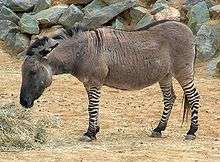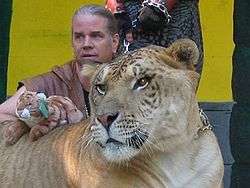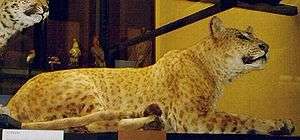List of genetic hybrids
This list is incomplete; you can help by expanding it.
This is a list of genetic hybrids which is limited to well documented cases of animals of differing species able to create hybrid offspring which may or may not be infertile.
Hybrids should not be confused with genetic chimeras, such as that between sheep and goat known as the geep. Wider interspecific hybrids can be made via in vitro fertilization or somatic hybridization, however the resulting cells are not able to develop into a full organism.
Nomenclature
The naming of hybrid animals depends on the sex and species of the parents. The father giving the first half of his species' name and the mother the second half of hers. (I.e. a pizzly bear has a polar bear father and grizzly bear mother whereas a grolar bear's parents would be reversed.)
Animals

A "zonkey", a zebra/donkey hybrid

Hercules, a "liger", a lion/tiger hybrid

A "jaglion", a jaguar/lion hybrid
A mule, a domestic canary/goldfinch hybrid.
- Hybrid iguana, a single‐cross hybrid resulting from natural interbreeding between male marine iguanas and female land iguanas since the late 2000s.
- Equid hybrids
- Bovid hybrids
- Dzo, zo or yakow; a cross between a domestic cow/bull and a yak.
- Beefalo, a cross of an American bison and a domestic cow. This is a fertile breed; this, along with mitochondrial DNA evidence,[1] has led bison to occasionally be classified in the genus Bos.
- Zubron, a hybrid between wisent (European bison) and domestic cow.
- Sheep-goat hybrids, such as the toast of Botswana.
- Ursid hybrids, such as the grizzly-polar bear hybrid, occur between black bears, brown bears, and polar bears.
- Felid hybrids
- Savannah cats are the hybrid cross between an African serval cat and a domestic cat
- A hybrid between a Bengal tiger and a Siberian tiger is an example of an intra-specific hybrid.
- Ligers and tiglons (crosses between a lion and a tiger) and other Panthera hybrids such as the lijagulep. Various other wild cat crosses are known involving the lynx, bobcat, leopard, serval, etc.
- Bengal cat, a cross between the Asian leopard cat and the domestic cat, one of many hybrids between the domestic cat and wild cat species. The domestic cat, African wild cat and European wildcat may be considered variant populations of the same species (Felis silvestris), making such crosses non-hybrids.
- Fertile canid hybrids occur between coyotes, wolves, dingoes, jackals and domestic dogs.
- Hybrids between black and white rhinoceroses have been recognized.
- Hybrids between spotted owls and barred owls
- Cama, a cross between a camel and a llama, also an intergeneric hybrid.
- Cetacean hybrids
- Wholphin, a fertile but very rare cross between a false killer whale and a bottlenose dolphin.
- In 2014, DNA analysis showed the clymene dolphin (Stenella clymene) to be a naturally occurring hybrid species descended from the spinner dolphin (Stenella longirostris) and the striped dolphin (Stenella coeruleoalba).[2]
- A fertile cross between a king snake and a corn snake.
- At Chester Zoo in the United Kingdom, a cross between an African elephant (male) and an Asian elephant (female). The male calf was named Motty. It died of intestinal infection after twelve days.
- Cagebird breeders sometimes breed hybrids between species of finch, such as goldfinch x canary. These birds are known as mules.
- Gamebird hybrids, hybrids between gamebirds and domestic fowl, including chickens, guineafowl and peafowl, interfamilial hybrids.
- Numerous macaw hybrids are also known.
- Red kite and black kite: five bred unintentionally at a falconry center in England. (It is reported that the black kite (the male) refused female black kites but mated with two female red kites.)
- Hybridization between the endemic Cuban crocodile (Crocodilus rhombifer) and the widely distributed American crocodile (Crocodilus acutus) is causing conservation problems for the former species as a threat to its genetic integrity.[3]
- Saltwater crocodiles (Crocodylus porosus) have mated with Siamese crocodiles (Crocodylus siamensis) in captivity producing offspring which in many cases have grown over 20 feet (6.1 metres) in length. It is likely that wild hybridization occurred historically in parts of southeast Asia.
- Blood parrot cichlid, which is probably created by crossing a red head cihclid and a Midas cichlid or red devil cichlid
- A group of about 50 hybrids between Australian blacktip shark and the larger common blacktip shark was found by Australia's East Coast in 2012. This is the only known case of hybridization in sharks.[4]
- The mulard duck, hybrid of the domestic Pekin duck and domesticated Muscovy ducks.
- Killer bees were created in an attempt to breed tamer and more manageable bees. This was done by crossing a european honey bee and an african bee, but instead the offspring became more aggressive and highly defensive bees that had escaped into the wild.
- Brewer's duck, hybrid of the Mallard and Gadwall.
- In Australia, New Zealand and other areas where the Pacific black duck occurs, it is hybridised by the much more aggressive introduced mallard. This is a concern to wildlife authorities throughout the affected area, as it is seen as genetic pollution of the black duck gene pool.
References
- ↑ Guo, S.; Liu, J.; Qi, D.; Yang, J.; Zhao, X. (2006). "Taxonomic placement and origin of yaks: implications from analyses of mtDNA D-loop fragment sequences". Acta Theriologica Sinica. 26 (4): 325–330.
- ↑ http://news.nationalgeographic.com/news/2014/01/140111-hybrid-dolphin-species-ocean-animal-science/#
- ↑ http://www.savingwildplaces.com/swp-home/swp-crocodile/8287793?preview=&psid=&ph=class%2525253dawc-148772
- ↑ Voloder, Dubravka (3 January 1012). "Print Email Facebook Twitter More World-first hybrid sharks found off Australia". ABC News. Retrieved 5 January 2012.
This article is issued from Wikipedia - version of the 12/3/2016. The text is available under the Creative Commons Attribution/Share Alike but additional terms may apply for the media files.